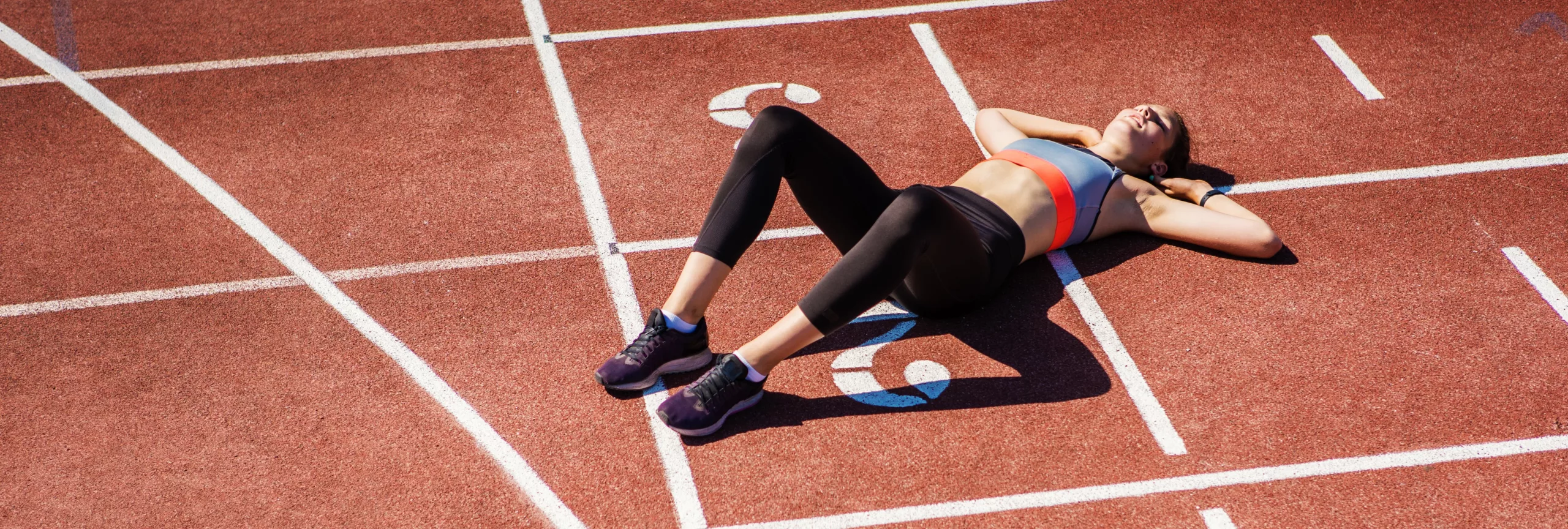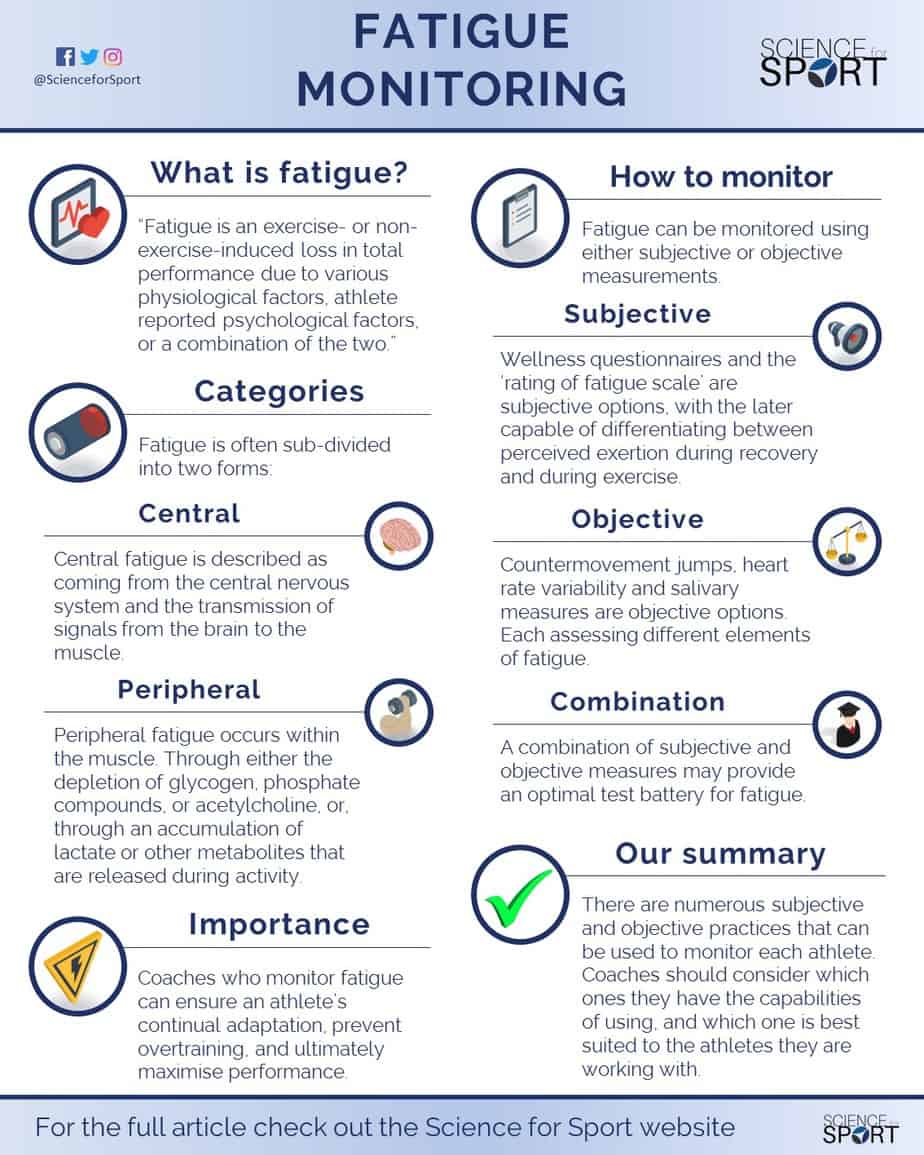Contents of Article
- Summary
- What is fatigue?
- Why is monitoring fatigue important?
- How do you monitor fatigue?
- Is future research into fatigue monitoring needed?
- Conclusion
- References
- About the Author
Summary
Fatigue monitoring is characterised by using various techniques in order to examine the physiological and psychological fatigue accumulated from training and competing in sport. This is a particularly important tool for coaches, sports scientists, and other practitioners alike due to the fact that high levels of fatigue can inhibit proper adaption to training and hinder performance in competition. Therefore, actively monitoring fatigue levels in athletes can provide important feedback needed to adjust training in order to improve overall performance.
There are several ways to monitor fatigue through different subjective (e.g. questionnaires) or objective (e.g. blood lactate) measures. Recently, much research has attempted to assess the validity and reliability of many of these measures (e.g. wellness questionnaires). While many practitioners have developed well-rounded fatigue monitoring programmes, there is still a huge demand for more research to verify the best methods for tracking fatigue.
There are many different considerations when implementing a development programme for athletes, one of which is to assess the athletes’ readiness to train and perform (i.e. ‘freshness’) – this concept has become known as ‘fatigue monitoring’. Teams ranging from professional to amateur have begun implementing their own fatigue monitoring systems with varied levels of success.

What is fatigue?
Muscle physiologists often have previously described fatigue as a decline in muscular force due to exercise (1). On the other hand, those in exercise science research referred to fatigue simply as an exercise-induced diminishment or impairment of performance (2). However, both of these definitions of fatigue fall somewhat short.
While both schools of thought agree that fatigue is related to objective measures (i.e. performance and physiology), they forget to include subjective measures (i.e. perceived stress, mood, etc.). It has been suggested appropriate fatigue monitoring should include both objective and subjective measures; including an aspect of ‘subjective-ness’ into the definition of fatigue is required (3). Because of this, perhaps the best current working definition of fatigue is ‘any exercise- or non-exercise-induced loss in total performance due to various physiological factors, athlete-reported psychological factors, or a combination of the two (4)’.
“Fatigue is any exercise- or non-exercise-induced loss in total performance due various physiological factors, athlete reported psychological factors, or a combination of the two.”
Since, by definition, fatigue reduces athletic performance capabilities, many have attempted to periodically measure the fatigue of their athletes so that they may adjust training protocols appropriately.
It is well-understood that training will induce numerous neurophysiological and psychological changes in an athlete’s body, and this is a completely normal part of the training process. Fatigue is often sub-divided into two distinct forms (5):
- Central fatigue
- Peripheral fatigue
Central fatigue
Central fatigue is described as fatigue coming not from the muscle itself, but rather from the central nervous system (CNS) and the transmission of signals from the brain to the muscle (6). Therefore, central fatigue is related to the brain and the spinal cord (7).
The human body is a complex system that wants to continually remain in homeostasis. Upon performing physical work, such as training, the CNS will provide neurotransmissions which, in turn, regulate the amount of work being completed. This is done in a regulatory attempt to prevent bodily harm from occurring. The signals coming from the CNS will experience fatigue which can differ on an individual basis (6).
It has been suggested that a significant difference between good and great athletes is their individual ability to ignore these neurotransmissions in an effort to complete the task at hand (6).
Peripheral fatigue
On the other hand, peripheral fatigue is the failure to maintain an expected power output (8) and can be caused by two different actions. The first is the depletion of glycogen, phosphate compounds, or acetylcholine within the muscular unit. Secondly, peripheral fatigue can be caused by the accumulation of lactate or other metabolites that are released during activity (9). Therefore, peripheral fatigue occurs within the muscle (7).
Why is monitoring fatigue important?
As training under high levels of fatigue can result in little to no training adaption, monitoring the amount of fatigue is therefore important for any coach, trainer, or sports scientist who is attempting to optimise an athlete’s performance (10). As such, monitoring the athlete’s freshness will provide the coach with some level of knowledge regarding the athlete’s sensitivity to adaptation and/or their ability to perform.

An athlete’s training programme (i.e. dose) and the corresponding levels of fatigue associated with that programme (i.e. response) is often referred to as the dose-response relationship (11). Therefore, a coach must fully understand the dose-response relationship of their athletes’ training programmes if they are to maximise performance, especially on the day of competition. Given this, the process of monitoring fatigue is an attempt to improve the so-called art of periodisation for competition with an ‘evidence-based decision-making system’.
In other words, the importance and advantage of implementing a fatigue monitoring system is having the ability to see how each athlete is responding to training. If the goal is to maximise or maintain performance, then having the knowledge as to how the athlete’s body is responding is critical. Knowing when an athlete is responding well to training, versus when the athlete is not, is essential from a training prescription standpoint.
Having this information will allow the coach to adjust an athlete’s training programme as necessary to ensure continual adaptation, prevent overtraining, and ultimately maximise performance.
How do you monitor fatigue?
As fatigue encompasses both objective and subjective elements, it is important to include monitoring protocols which assess both facets. Listed below are some of the more commonly used, and thoroughly researched, methods of collecting data to determine fatigue.
Subjective tests
Wellness Questionnaires
Wellness questionnaires, otherwise referred to as athlete self-report measures, are simply questionnaires given to the athlete for them to rate how they feel. This will often cover a range of topics such as how they slept the previous night, their current stress level, body soreness, and how tired they feel (12).
The list of questions, and the structure of the questionnaire, are commonly designed by the coach based on what they feel is most important for their athletes. For example, a coach working with university athletes may choose to include questions regarding school workload, as this is known to impose a certain degree of stress and limit physical adaptations (13). On the other hand, a coach working with professional athletes may, of course, not choose to include this type of question for obvious reasons.
There is a substantial list of various different wellness questionnaires available for coaches to use (3), however, it is important to understand that only some have been scientifically studied and found to be sensitive to changes in weekly training regimens (14). In a recent study that involved 50 elite/professional programmes, 84 % of respondents reported using wellness questionnaires (15). Of these, 80 % of the respondents said they prefer to use custom-designed questionnaires – most of which are unlikely to have been validated by research.
Regardless, given their low-cost nature and ability to provide immediate feedback, wellness questionnaires work well as a fatigue monitoring tool, especially with large groups such as in a team sport setting (16).
Rating of Fatigue Scale
Rating of fatigue is one of the newest developments in fatigue monitoring, and it has so far been shown to have good face validity and high levels of convergent validity (4). This scale is designed to provide a holistic measure of how fatigued an individual feels.
This is done through the use of an 11-point Likert scale with diagrammatic selections. This two-part system seems to make the rating easier for participants and, therefore, provides a more accurate way of determining perceived fatigue levels. Not only does the Rating of Fatigue scale appear to have a high correlation with physiological markers, but it also appears to be capable of differentiating between perceived exertion during recovery and during exercise (4). These findings suggest that the Rating of Fatigue scale may be a superior way of monitoring fatigue in comparison to many traditional methods.
Objective tests
Countermovement Jump
Countermovement jump (CMJ) testing is a popular method for monitoring fatigue due its simplicity, and because it takes little time to measure (17). CMJ tests can be used to measure power, velocity, and/or jump displacement (18), and have been shown to be sensitive to match-induced fatigue (17, 19-22). Furthermore, in a meta-analysis of 151 research articles, it was reported that the average CMJ height is more sensitive to neuromuscular fatigue than the highest CMJ height (23).
Heart Rate Variability
The interest in heart rate variability (HRV) appears to be growing year-on-year as a tool for measuring the body’s reaction to training and its associated levels of fatigue (24). HRV is simply a measure of the differences in the time from heartbeat to heartbeat. As HRV reflects the autonomic nervous system function, and thus stress, it is frequently used in the athletic world to identify periods of optimal training, monitor recovery status, and to flag any potential overtraining (25).
One of the main drawbacks of using HRV is that it is somewhat difficult and time-consuming to measure. HRV requires an athlete to be at complete rest and as relaxed as possible for the most accurate measure (26). This could be time-consuming, as getting an athlete to relax can potentially take several minutes or more. Other variables, such as body positioning (e.g. sitting vs. standing), or the time of day, can also play a role in the tests accuracy (27). Due to the high number of variables involved in this measurement, it is suggested HRV should not be used as a sole measure of fatigue and readiness, but rather in conjunction with other testing protocols (16).
Saliva Measures
While historically not the most popular method used, testing hormonal levels in saliva has been shown to provide an accurate measure of fatigue (28). Testing has shown that levels of hormones such as cortisol and testosterone taken from saliva samples change during and after physical activity and that an individual’s biochemical response can be determined by looking at these changes (29).
For example, throughout a rugby match, levels of cortisol have been shown to increase to around 2.5 times the pre-match levels (i.e. baseline) and return back to baseline within four hours (30). On the other hand, testosterone levels appear to decrease. During the five-day recovery period, cortisol levels appear to be lower, and testosterone levels higher, in comparison to baseline testing, which can result in a high testosterone-cortisol ratio (30). The high testosterone-cortisol ratio observed after competition, and during recovery, is most likely required to restore the break-down of homeostasis induced by the rugby match (30).
By looking at the testosterone-cortisol ratio in comparison to their baseline scores, the practitioner can determine how an athlete is coping with training or competition, as well as how they are recovering. The advantage of testing markers found in saliva is that they can be very accurate (31). However, performing these tests requires expensive equipment and resources, therefore limiting their practicality.
In summary, no matter what test is chosen, it is important to have solid baseline measures. It should also be understood that comparing test findings with a baseline measure from different phases of the year than you are currently in (e.g. competitive season, pre-season, post-season), will not allow for meaningful comparison. For example, if an athlete is in the middle of a competitive season, the baseline measure should be from the beginning of that competitive season. This way the baseline data is generated while the athlete is in a physical and mental state most similar to that in which they will be training and performing in moving forward.
Is future research into fatigue monitoring needed?
While much research has been conducted on the topic of fatigue monitoring, there is still a significant lack of evidence to draw definitive conclusions about which protocols are best, or at least most applicable. As a result, future research into the topic needs to be conducted in order to find the best, and most practical, methods for monitoring athlete readiness. Future research topics should look to:
- Further validation of the Rating of Fatigue Scale.
- Assess the validity and reliability of the many wellness questionnaires.
- Determine the simplest and most valid measure for assessing fatigue.
- Gather larger data sets that are narrower in scope as to draw better conclusions.
Methods of fatigue monitoring that are easy to implement and use on a consistent basis need to be addressed more thoroughly in the coming years. Eventually, the goal should be to have a scientifically proven method, or methods, that every coach with basic tools and knowledge can implement and use successfully.
Conclusion
At its core, fatigue monitoring is simply a method of assessing an athlete’s readiness to train or compete. It is easy to see how this could be extremely important for the coach looking to take their athlete to the next level, however, fatigue monitoring is not a simple subject. There are numerous subjective and objective practices that can be used to monitor each athlete, some of which are much simpler than others, and some methods are better supported by research.
Before implementing a fatigue monitoring system, the practitioner should determine which methods are supported by research, which ones they have the capabilities of using, and also which one is best suited to the athletes they are working with. Having a consistent and accurate set of data to work with will give the best results and, in turn, have the best positive effect on the training of each athlete.
- Edwards RH. “Human Muscle Function and Fatigue.” Ciba Foundation Symposium. National Institute of Health. February 1981. ncbi.nlm.nih.gov/pubmed/6117420.
- Knicker AJ, Renshaw I, Oldham AR, Cairns SP. “Interactive Processs Link Mulitple Symptoms of Fatigue in Sport.” Sports Medicine. Volume 41, Issue 4. April 2011. https://www.ncbi.nlm.nih.gov/pubmed/21425889
- Saw AE, Main LC, Gastin PB. “Monitoring the athlete training response: subjective self-reported measures trump commonly used objective measures: a systematic review.” British Journal of Sports Medicine. September 9, 2016. http://bjsm.bmj.com/content/early/2015/09/30/bjsports-2015-094758
- Micklewright D, Gibson ASC, Gladwell V, Salman AA. “Development and Validity of the Rating-of-Fatigue Scale.” Sports Medicine. March 2017. https://www.ncbi.nlm.nih.gov/pubmed/28283993
- Carroll TJ, Taylor JL, Gandevia SC. Recovery of central and peripheral neuromuscular fatigue after exercise. J Appl Physiol. doi:10.1152/japplphysiol.00775.2016. https://www.ncbi.nlm.nih.gov/pubmed/27932676
- Noakes, Timothy David. “Fatigue Is a Brain-Derived Emotion That Regulates the Exercise Behavior to Ensure the Protection of Whole Body Homeostasis.” Frontiers in Physiology3 (2012): 82. PMC. https://www.ncbi.nlm.nih.gov/pmc/articles/PMC3323922/
- Zając A, Chalimoniuk M, Maszczyk A, Gołaś A, Lngfort J. Central and Peripheral Fatigue During Resistance Exercise – A Critical Review. Journal of Human Kinetics volume 49/2015, 159-169.
- Kirkdenall, DT. (1990). “Mechanisms of Peripheral Fatigue.” Medicine and Science in Sports and Exercise. 22. 44-9. https://www.ncbi.nlm.nih.gov/pubmed/2205780
- Asmussen, E. (1979). “Muscle Fatigue.” Medicine and Science in Sports, II. 313-321.
- Zatsiorsky VM, Kraemer WJ. “Science and Practice of Strength Training.” 2nd Human Kinetics. 2006. http://www.humankinetics.com/products/all-products/science-and-practice-of-strength-training-2nd-edition
- Matveyev, L. 1981. Foundations of Sports Training. Moscow: Progress.
- Rushall, B.S. 1990. A Tool for Measuring Stress Tolerance in Elite Athletes. Journal of Applied Sports Psychology, 2(1): 51-66. https://www.researchgate.net/publication/247515243_A_tool_for_measuring_stress_tolerance_in_elite_athletes
- Bartholomew, JB, Stults-Kolehmainen, MA, Elrod, CC, and Todd, JS. Strength gains after resistance training: the effect of stressful, negative life events. J Strength Cond Res 22: 1215–1221, 2008. https://www.ncbi.nlm.nih.gov/pubmed/18545186
- Gastin PB, Meyer D, Robinson D. “Perception of wellness to monitor adaptive responses to training and competition in elite Australian football.” The Journal of Strength and Conditioning Research. September 2013. ncbi.nlm.nih.gov/pubmed/23249820
- Taylor, K, Chapman, DW, Cronin, JB, Newton, MJ, and Gill, N. Fatigue monitoring in high performance sport: A survey of current trends. J Aust Strength Cond 20: 12–23, 2012. https://www.researchgate.net/publication/270905024_Fatigue_Monitoring_in_High_Performance_Sport_A_Survey_of_Current_Trends
- Coutts AJ, Cormack S. “Monitoring the Training Response.” High-Performance Training for Sports. Edited by Joyce D, Lewindon D. Human Kinetics, 2014.
- Roe G, Till K, Darrall-Jones J, et al. Changes in Markers of Fatigue Following a Competitive Match in Academy Rugby Union Players. South Afric J Sports Med. 2016;(In Press). https://www.researchgate.net/publication/302868480_Changes_in_Markers_of_Fatigue_Following_a_Competitive_Match_in_Academy_Rugby_Union_Players
- Welsh, T.T., J.A. Alemany, S,J, Montain, P.N. Frykman, A.P. Tuckow, A.J. Young, and B.C, Nindl. 2008. Effects of Intensified Military Field Training on Jumping Performance. International Journal of Sports Medicine, 29(1): 45-52. https://www.ncbi.nlm.nih.gov/pubmed/17879876
- Twist C, Waldron M, Highton J, Burt D, Daniels M. Neuromuscular, biochemical and perceptual post-match fatigue in professional rugby league forwards and backs. J Sports Sci. 2012;30:359-367. https://www.ncbi.nlm.nih.gov/pubmed/22176201
- Johnston RD, Gabbett TJ, Jenkins DG, Hulin BT. Influence of physical qualities on post-match fatigue in rugby league players. J Sci Med Sport. 2015;18:209-213. https://www.ncbi.nlm.nih.gov/pubmed/24594214
- McLellan CP, Lovell DI, Gass GC. Markers of postmatch fatigue in professional Rugby League players. J Strength Cond Res. 2011;25:1030-1039. https://www.ncbi.nlm.nih.gov/pubmed/20703169
- West DJ, Finn CV, Cunningham DJ, et al. Neuromuscular function, hormonal, and mood responses to a professional rugby union match. J Strength Cond Res. 2014;28:194-200. https://www.ncbi.nlm.nih.gov/pubmed/23539085
- Claudino JC, Cronin J, Tricoli V, McMaster DT, Serrao JC. “The Countermovement Jump to Monitor Neuromuscular Status: A Meta-Analysis.” Journal of Science and Medicine in Sport. August 2016. https://www.ncbi.nlm.nih.gov/pubmed/27663764
- Pinna GD, Maestri R, Torunski A, Danilowicz-Szymanowicz L, Szwoch M, La Rovere MT, Raczak G. Heart rate variability measures: a fresh look at reliability. Clin Sci (Lond). 2007 Aug;113(3):131-40. https://www.ncbi.nlm.nih.gov/pubmed/17381425
- Aubert AE, Seps B, Beckers F. Heart rate variability in athletes. Sports Med. 2003;33(12):889-919. https://www.ncbi.nlm.nih.gov/pubmed/12974657
- Flatt AA and Esco MR. Heart rate variability stabilization in athletes: towards more convenient data acquisition. Clin Physiol Funct Imaging In Press, 2015. https://www.ncbi.nlm.nih.gov/pubmed/25754514
- Fatisson, Julien, Victor Oswald, and François Lalonde. “Influence Diagram of Physiological and Environmental Factors Affecting Heart Rate Variability: An Extended Literature Overview.” Heart International1 (2016): e32–e40. PMC. https://www.ncbi.nlm.nih.gov/pmc/articles/PMC5056628/
- Vining, R.F., R.A. McGinley, and R.G. Symons. 1983. Hormones in Saliva: Mode of Entry and Consequent Implications for Clinical Interpretation. Clinical Chemistry, 29(10): 1752-1756. https://www.ncbi.nlm.nih.gov/pubmed/6225566
- Cormack, S.J., R.U. Newton, and M.R. McGuigan. (2008) Neuromuscular and Endocrine Responses of Elite Players to an Australian Rules Football Season. International Journal of Sports Physiology and Performance, 3(3): 359-374. https://www.ncbi.nlm.nih.gov/pubmed/19223670
- Elloumi M, Maso F, Michaux O, Robert A, Lac G. “Behavior of saliva cortisol, testosterone, and the T/C ratio during a rugby match and during the post-competition recovery days,” European Journal of Applied Physiology. September 2003. ncbi.nlm.nih.gov/pubmed/12783234
- Hagen, J., Gott, N., Miller, D.R. Reliability of Saliva Hormone Tests. Journal of American Pharmacists Association. 2003. Vol. 43. Issue 6. https://www.ncbi.nlm.nih.gov/pubmed/14717270





